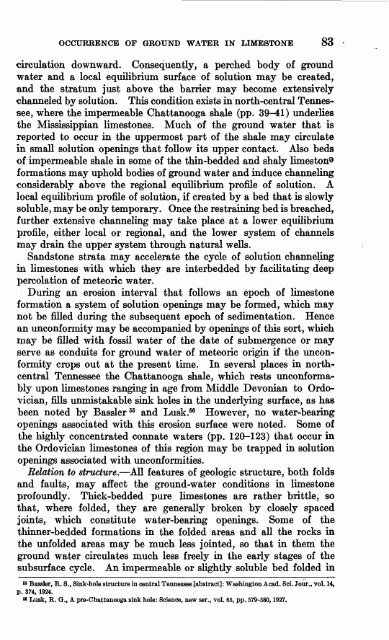GROUND WATER IN NORTH-CENTRAL TENNESSEE
GROUND WATER IN NORTH-CENTRAL TENNESSEE
GROUND WATER IN NORTH-CENTRAL TENNESSEE
You also want an ePaper? Increase the reach of your titles
YUMPU automatically turns print PDFs into web optimized ePapers that Google loves.
OCCURRENCE OF <strong>GROUND</strong> <strong>WATER</strong> <strong>IN</strong> LIMESTONE 83<br />
circulation downward. Consequently, a perched body of ground<br />
water and a local equilibrium surface of solution may be created,<br />
and the stratum just above the barrier may become extensively<br />
channeled by solution. This condition exists in north-central Tennes<br />
see, where the impermeable Chattanooga shale (pp. 39-41) underlies<br />
the Mississippian limestones. Much of the ground water that is<br />
reported to occur in the uppermost part of the shale may circulate<br />
in small solution openings that follow its upper contact. Also beds<br />
of impermeable shale in some of the thin-bedded and shaly limeston®<br />
formations may uphold bodies of ground water and induce channeling<br />
considerably above the regional equilibrium profile of solution. A<br />
local equilibrium profile of solution, if created by a bed that is slowly<br />
soluble, may be only temporary. Once the restraining bed is breached,<br />
further extensive channeling may take place at a lower equilibrium<br />
profile, either local or regional, and the lower system of channels<br />
may drain the upper system through natural wells.<br />
Sandstone strata may accelerate the cycle of solution channeling<br />
in limestones with which they are interbedded by facilitating deep<br />
percolation of meteoric water.<br />
During an erosion interval that follows an epoch of limestone<br />
formation a system of solution openings may be formed, which may<br />
not be filled during the subsequent epoch of sedimentation. Hence<br />
an unconformity may be accompanied by openings of this sort, which<br />
may be filled with fossil water of the date of submergence or may<br />
serve as conduits for ground water of meteoric origin if the uncon<br />
formity crops out at the present time. In several places in north-<br />
central Tennessee the Chattanooga shale, which rests unconforma-<br />
bly upon limestones ranging in age from Middle Devonian to Ordo-<br />
vician, fills unmistakable sink holes in the underlying surface, as has<br />
been noted by Bassler 55 and Lusk.66 However, no water-bearing<br />
openings associated with this erosion surface were noted. Some of<br />
the highly concentrated connate waters (pp. 120-123) that occur in<br />
the Ordovician limestones of this region may be trapped in solution<br />
openings associated with unconformities.<br />
Relation to structure. All features of geologic structure, both folds<br />
and faults, may affect the ground-water conditions in limestone<br />
profoundly. Thick-bedded pure limestones are rather brittle, so<br />
that, where folded, they are generally broken by closely spaced<br />
joints, which constitute water-bearing openings. Some of the<br />
thinner-bedded formations in the folded areas and all the rocks in<br />
the unfolded areas may be much less jointed, so that in them the<br />
ground water circulates much less freely in the early stages of the<br />
subsurface cycle. An impermeable or slightly soluble bed folded in<br />
« Bassler, R. S., Sink-hole structure in central Tennessee [abstract]: Washington Acad. Sci. Jour., vol. 14,<br />
p. 374, 1924.<br />
M Lusk, R. G., A pre-Chattanooga sink hole: Science, new ser., vol. 65, pp. 579-580,1927.

















